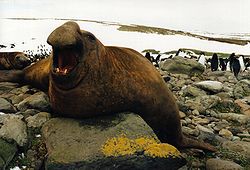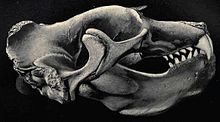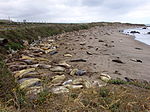- Elephant seal
-
- "Sea elephant" redirects here. This may also refer to sea slugs of superfamily Pterotracheoidea.
Elephant seal 
Male and female northern elephant seals Scientific classification Kingdom: Animalia Phylum: Chordata Class: Mammalia Order: Carnivora Suborder: Pinnipedia Family: Phocidae Genus: Mirounga Species Elephant seals (sea elephants) are large, oceangoing seals in the genus Mirounga. There are two species: the northern elephant seal (M. angustirostris) and the southern elephant seal (M. leonina). Both were hunted to the brink of extinction by the end of the 19th century, but numbers have since recovered. The northern elephant seal, somewhat smaller than its southern relative, ranges over the Pacific coast of the U.S., Canada and Mexico. The most northerly breeding location on the Pacific Coast is at Race Rocks, at the southern tip of Vancouver Island in the Strait of Juan de Fuca. The southern elephant seal is found in the Southern Hemisphere on islands such as South Georgia, Macquarie Island, and on the coasts of New Zealand, South Africa, and Argentina in the Peninsula Valdés, which is the fourth largest elephant seal colony in the world.
Contents
Description
Elephant seals take their name from the large proboscis of the adult males (bulls) which resembles an elephant's trunk.[1] The bull's proboscis is used in producing extraordinarily loud roaring noises, especially during the mating season. More importantly, however, the nose acts as a sort of rebreather, filled with cavities designed to reabsorb moisture from the animals' exhalations. This is important during the mating season when the male seals rarely leave the beach to feed and therefore must conserve body moisture as they have no incoming source of water. Bulls of both the northern and the southern elephant seals reach a length of 16 feet (4.9 m) and a weight of 6,600 pounds (3,000 kg), and are much larger than the cows, which typically measure about 10 feet (3.0 m) and 2,000 pounds (910 kg).[2][3]
Physiology
 Male northern elephant seals fighting in California
Male northern elephant seals fighting in California
Elephant seals spend upwards of 80% of their lives in the ocean. They can hold their breath for more than 100 minutes[4][5] — longer than any other non-cetacean mammal. Elephant seals dive to 1550 m beneath the ocean's surface[6] (the deepest recorded dive of an elephant seal is 2,388 metres (7,835 ft) by a southern elephant seal).[7] The average depth of their dives is about 300 to 600 metres (2,000 ft), typically for around 20 min for females and 60 min (1 hour) for males, as they search for their favorite foods, which are skates, rays, squid, octopuses, eels, penguin (southerns only), small sharks, and large fish. Their stomachs also often contain gastroliths. While excellent swimmers, they are also capable of rapid movement on land.
Elephant seals are shielded from extreme cold by their blubber, more so than by fur. The animals' hair and outer layers of skin molt periodically. The skin has to be regrown by blood vessels reaching through the blubber. When molting occurs, the seal is susceptible to the cold, and must rest on land, in a safe place called a "haul out". While the molt is taking place, the bulls cease fighting with one another, as there are then no breeding harems and females in estrous to protect. Northern males haul out in August, and females in May–June.
Elephant seals have a very large volume of blood, allowing them to hold a large amount of oxygen for use when diving. They have large sinuses in their abdomens to hold blood and can also store oxygen in their muscles with increased myoglobin concentrations in muscle. In addition, they have a larger proportion of oxygen-carrying red blood cells. These adaptations allow elephant seals to dive to such depths and remain underwater for up to two hours.[8]
Lifespan
Female elephant seals have an average life expectancy of about 23 years, and can give birth starting at the age of four to five. Males reach maturity at five years, but generally do not achieve alpha status until the age of eight, with the prime breeding years being between ages 9 and 12. The average life expectancy of a male elephant seal is 20 years. Only one in 10 males will become an alpha or beta male.
Gallery
Elephant seals (Mirounga angustirostris) on a beach, San Simeon, CaliforniaMale, female and pupNorthern elephant seals during molting season near San Simeon, CaliforniaTwo bull males fightingElephant seal snoutJuvenile southern elephant sealSee also
- Marine Mammal Center
- Penelope Seal
- Marine Life
References
- ^ Mirounga. "Elephant Seal, Elephant Seal Profile, Facts, Information, Photos, Pictures, Sounds, Habitats, Reports, News - National Geographic". Animals.nationalgeographic.com. http://animals.nationalgeographic.com/animals/mammals/elephant-seal.html. Retrieved 2009-01-08.
- ^ "Elephant Seals". Parks.ca.gov. 2007-05-23. http://www.parks.ca.gov/?page_id=1115. Retrieved 2009-01-08.
- ^ "Elephant Seal - MSN Encarta". Encarta.msn.com. Archived from the original on 2009-10-31. http://www.webcitation.org/5kwbhJNuj. Retrieved 2009-12-29.
- ^ "BBC NEWS". BBC News. 2006-02-21. http://news.bbc.co.uk/2/hi/science/nature/4736196.stm. Retrieved 2010-05-22.
- ^ "Southern Elephant Seals of Sea Lion Island - A Long-term Research Project". www.eleseal.org. http://www.eleseal.org/pdf_lay/book_2004.pdf. Retrieved 2010-05-21.
- ^ Amos, Jonathan (2006-02-21). "BBC NEWS | Science/Nature | Elephant seals dive for science". BBC News. http://news.bbc.co.uk/2/hi/science/nature/4736196.stm. Retrieved 2009-01-08.
- ^ "Census of Marine Life - From the Edge of Darkness to the Black Abyss". Coml.org. http://www.coml.org/comlfiles/press/CoML_Beyond_Sunlight_11.17.2009_Public.pdf. Retrieved 2009-12-15.
- ^ "5.4 Seals". Classroom Antarctica. http://www.classroom.antarctica.gov.au/5-southern-life/5-4-seals. Retrieved July 2011.
External links
- Tagging of Pacific Predators, Elephant Seals
- Friends of the Elephant seal
- Elephant Seal Research Group
- Elephant seals
- Dr. Daniel Costa's Research Laboratory
- Elephant Seals at Race Rocks, Canada
Categories:- True seals
Wikimedia Foundation. 2010.









